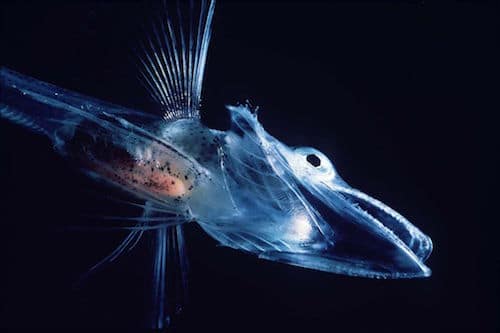 Evolution
Evolution
 Intelligent Design
Intelligent Design
Information and Mutation — Responding to David Levin

David E. Levin, who teaches in the Department of Molecular & Cell Biology at Boston University’s School of Dental Medicine, wrote an emotional negative review of my latest book, The Evolution Revolution, for the online journal Reports of the National Center for Science Education. He also posted it on my book’s Amazon page. I replied here at Evolution News.
In the meantime, Levin has responded again on Amazon, interacting with another commenter, “Les.” <href=”#Mx3BB8XJKSOMIWT”>Levin writes:
Only the mutational aspect of the evolutionary process is random (in the sense that it is not directed). Natural selection provides direction to the process. It is anything but random. In fact, natural selection is the sculpting of the genome by the environment. But this has been explained to you many times over.
I especially like the example of the evolution of the antifreeze gene of Antarctic Notothenioid fish (in part because it’s accepted by well known ID proponent Michael Behe). The evolutionary history of this gene is well documented. The new gene arose from the non-coding region of a gene encoding a digestive enzyme through the accumulation of a series of random mutations that were selected for serially in the context of a cooling Antarctic. The antifreeze gene is now essential to the survival of these fish. So, this is just one well-documented example of how evolution increases order (or adds information) to a genome.
http://www.ncbi.nlm.nih.gov/pmc/articles/PMC34156/
By the way, this directly contradicts Spetner’s assertion that there are no examples of random mutations that increase information in the genome.
Twenty years ago I wrote: “No random mutation has been observed that adds information to the genome.” I repeated this in my latest book and the statement still stands. It bothers the Darwinists because it refutes common descent and Darwinian evolution.
 How does one know that a mutation has occurred and how does one know it is random? If two closely related species have similar proteins or DNA, Darwinists assume the differences in the sequences represent random mutations that occurred in the evolutionary divergence of the species. No one knows that those genetic changes were random — they are simply declared random according to the dogma of the Modern Synthesis (MS).
How does one know that a mutation has occurred and how does one know it is random? If two closely related species have similar proteins or DNA, Darwinists assume the differences in the sequences represent random mutations that occurred in the evolutionary divergence of the species. No one knows that those genetic changes were random — they are simply declared random according to the dogma of the Modern Synthesis (MS).
The MS, however, currently faces intense scrutiny. As a replacement for the MS, some now offer the Extended Synthesis (ES), presently in formation. The ES suggests that genetic changes can occur in response to environmental stimuli. This is what I proposed twenty years ago with my nonrandom evolutionary hypothesis (NREH). But my hypothesis goes further than the ES is willing to go. The NREH says that living organisms are endowed with a built-in mechanism to respond adaptively to a range of environmental stimuli. The genetic changes are triggered by environmental stimuli, are adaptive, are not essentially random, and do not represent new information. The NREH can account for much of the evolution we see. The NREH does not address the issue of the origin of this built-in mechanism, but it does account for the data. Origins are hard to account for and neither the MS nor any published suggestion of an ES can account for origins.
Darwinists, under the influence of the MS, infer the occurrence of random mutations by comparing DNA or protein sequences of different species. Those inferences are not observations of random mutations. They call them random on the unsupported assumption that all molecular differences between species are the results of random mutations occurring during evolution. They assume this only because the Modern Synthesis postulates it. But an inference based on an unsupported assumption is not an observation and in this case is more likely to be wrong than right.
Random mutations have never been shown theoretically to be able to lead to the kind of evolution assumed to yield common descent. To show that they can do so requires a calculation of the probability of common descent, showing it to be reasonably high, but every attempt to make that calculation has shown the probability to be vanishingly small. The evidence offered for common descent is circumstantial only. There is no observation, for example, of any portion of the long line of the alleged evolutionary steps (i.e., actual births) from fish to amphibia. It is all inference based on circumstantial evidence. To connect circumstantial evidence to the conclusion of common descent requires a theory. There is no theory that predicts common descent and it is therefore a failed concept.
Some mutations, which are reasonably taken to be random, have been observed in single-celled organisms and some of them have even been adaptive. But no case has ever been reported where any one of them has increased the information content of the genome. While some mutations have been observed to be adaptive in special circumstances, these mutations always involve the loss, not gain, of information. For example, mutations can increase the rate of a biochemical reaction in a circumstance where this would be of benefit to the organism, but this benefit derives from the mutation’s having disabled a repressor, allowing a gene to be transcribed without control. Such a mutation cannot contribute to common descent because no matter how many millions of times mutations may disable a repressor they cannot build the information required for common descent. Such a mutation, again, loses information rather than gains it.
In the last fifty years it has become recognized that if evolution occurs in the sense of common decent, information has to be built up. For a primitive cell to evolve into an elephant, for example, the evolutionary process has to increase the information from that in the cell until an elephant’s worth of information has been achieved. There is no theory that can account for such a thing.
My statement above is a denial of Darwinian evolution or any derivative of it that depends on random mutations. Darwinians would therefore like to refute it. Levin, in the paragraph quoted above, has made a futile attempt to do so. He claims the antifreeze proteins found in Arctic and Antarctic fishes arose by random mutations and are therefore examples of random mutations adding new information to the genome. That these proteins arose by random mutation is not only an unsupported conjecture, but to have these proteins evolve by random mutations defies the essence of probability that says that an event with too small a probability is unlikely to occur. The antifreeze proteins are said to have evolved independently in Arctic and Antarctic fish — an extremely unlikely event if the mutations are random. These proteins cannot have arisen by random mutations and the example does not refute my statement. I repeat: No random mutation has been observed that adds information to the genome.
Furthermore, Levin doesn’t understand what natural selection is supposed to do. He doesn’t understand that evolutionary theory describes a random process. He thinks natural selection can eliminate randomness. However, all natural selection does is kill off the less adaptive organisms and allow the more adaptive ones to survive and proliferate. Where do those more adaptive ones come from? According to the current evolutionary theory (the MS) that’s what random mutations are supposed to accomplish. So according to the theory, the information buildup required by common descent can come only from random mutations.
Levin doesn’t understand this. He doesn’t understand evolution. So much for his commentary on my book.
